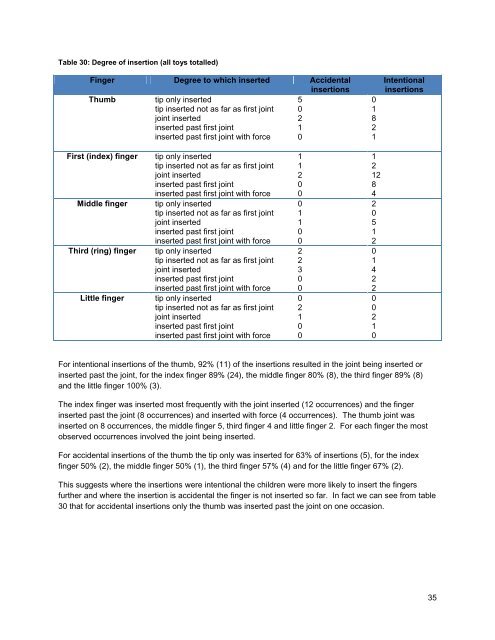Requirements for finger entrapment in European safety ... - ANEC
Requirements for finger entrapment in European safety ... - ANEC
Requirements for finger entrapment in European safety ... - ANEC
Create successful ePaper yourself
Turn your PDF publications into a flip-book with our unique Google optimized e-Paper software.
Table 30: Degree of <strong>in</strong>sertion (all toys totalled)<br />
F<strong>in</strong>ger Degree to which <strong>in</strong>serted Accidental<br />
<strong>in</strong>sertions<br />
Thumb tip only <strong>in</strong>serted<br />
5<br />
tip <strong>in</strong>serted not as far as first jo<strong>in</strong>t 0<br />
jo<strong>in</strong>t <strong>in</strong>serted<br />
2<br />
<strong>in</strong>serted past first jo<strong>in</strong>t<br />
1<br />
<strong>in</strong>serted past first jo<strong>in</strong>t with <strong>for</strong>ce 0<br />
0<br />
1<br />
8<br />
2<br />
1<br />
Intentional<br />
<strong>in</strong>sertions<br />
First (<strong>in</strong>dex) <strong>f<strong>in</strong>ger</strong><br />
Middle <strong>f<strong>in</strong>ger</strong><br />
Third (r<strong>in</strong>g) <strong>f<strong>in</strong>ger</strong><br />
Little <strong>f<strong>in</strong>ger</strong><br />
tip only <strong>in</strong>serted<br />
tip <strong>in</strong>serted not as far as first jo<strong>in</strong>t<br />
jo<strong>in</strong>t <strong>in</strong>serted<br />
<strong>in</strong>serted past first jo<strong>in</strong>t<br />
<strong>in</strong>serted past first jo<strong>in</strong>t with <strong>for</strong>ce<br />
tip only <strong>in</strong>serted<br />
tip <strong>in</strong>serted not as far as first jo<strong>in</strong>t<br />
jo<strong>in</strong>t <strong>in</strong>serted<br />
<strong>in</strong>serted past first jo<strong>in</strong>t<br />
<strong>in</strong>serted past first jo<strong>in</strong>t with <strong>for</strong>ce<br />
tip only <strong>in</strong>serted<br />
tip <strong>in</strong>serted not as far as first jo<strong>in</strong>t<br />
jo<strong>in</strong>t <strong>in</strong>serted<br />
<strong>in</strong>serted past first jo<strong>in</strong>t<br />
<strong>in</strong>serted past first jo<strong>in</strong>t with <strong>for</strong>ce<br />
tip only <strong>in</strong>serted<br />
tip <strong>in</strong>serted not as far as first jo<strong>in</strong>t<br />
jo<strong>in</strong>t <strong>in</strong>serted<br />
<strong>in</strong>serted past first jo<strong>in</strong>t<br />
<strong>in</strong>serted past first jo<strong>in</strong>t with <strong>for</strong>ce<br />
1<br />
1<br />
2<br />
0<br />
0<br />
0<br />
1<br />
1<br />
0<br />
0<br />
2<br />
2<br />
3<br />
0<br />
0<br />
0<br />
2<br />
1<br />
0<br />
0<br />
1<br />
2<br />
12<br />
8<br />
4<br />
2<br />
0<br />
5<br />
1<br />
2<br />
0<br />
1<br />
4<br />
2<br />
2<br />
0<br />
0<br />
2<br />
1<br />
0<br />
For <strong>in</strong>tentional <strong>in</strong>sertions of the thumb, 92% (11) of the <strong>in</strong>sertions resulted <strong>in</strong> the jo<strong>in</strong>t be<strong>in</strong>g <strong>in</strong>serted or<br />
<strong>in</strong>serted past the jo<strong>in</strong>t, <strong>for</strong> the <strong>in</strong>dex <strong>f<strong>in</strong>ger</strong> 89% (24), the middle <strong>f<strong>in</strong>ger</strong> 80% (8), the third <strong>f<strong>in</strong>ger</strong> 89% (8)<br />
and the little <strong>f<strong>in</strong>ger</strong> 100% (3).<br />
The <strong>in</strong>dex <strong>f<strong>in</strong>ger</strong> was <strong>in</strong>serted most frequently with the jo<strong>in</strong>t <strong>in</strong>serted (12 occurrences) and the <strong>f<strong>in</strong>ger</strong><br />
<strong>in</strong>serted past the jo<strong>in</strong>t (8 occurrences) and <strong>in</strong>serted with <strong>for</strong>ce (4 occurrences). The thumb jo<strong>in</strong>t was<br />
<strong>in</strong>serted on 8 occurrences, the middle <strong>f<strong>in</strong>ger</strong> 5, third <strong>f<strong>in</strong>ger</strong> 4 and little <strong>f<strong>in</strong>ger</strong> 2. For each <strong>f<strong>in</strong>ger</strong> the most<br />
observed occurrences <strong>in</strong>volved the jo<strong>in</strong>t be<strong>in</strong>g <strong>in</strong>serted.<br />
For accidental <strong>in</strong>sertions of the thumb the tip only was <strong>in</strong>serted <strong>for</strong> 63% of <strong>in</strong>sertions (5), <strong>for</strong> the <strong>in</strong>dex<br />
<strong>f<strong>in</strong>ger</strong> 50% (2), the middle <strong>f<strong>in</strong>ger</strong> 50% (1), the third <strong>f<strong>in</strong>ger</strong> 57% (4) and <strong>for</strong> the little <strong>f<strong>in</strong>ger</strong> 67% (2).<br />
This suggests where the <strong>in</strong>sertions were <strong>in</strong>tentional the children were more likely to <strong>in</strong>sert the <strong>f<strong>in</strong>ger</strong>s<br />
further and where the <strong>in</strong>sertion is accidental the <strong>f<strong>in</strong>ger</strong> is not <strong>in</strong>serted so far. In fact we can see from table<br />
30 that <strong>for</strong> accidental <strong>in</strong>sertions only the thumb was <strong>in</strong>serted past the jo<strong>in</strong>t on one occasion.<br />
35
















